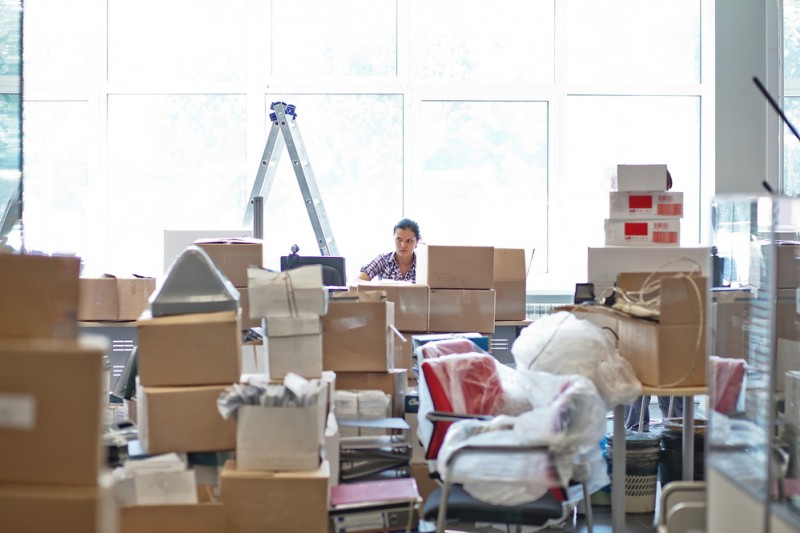Commercial vs. Corporate Moving: Service That Fits Your Needs
February 6, 2025
Moving a business is a significant endeavor, requiring careful planning and the right type of moving service to ensure a smooth transition. But what’s the difference between commercial moving and corporate moving, and which one best suits your business needs? Understanding the distinctions between these two services can help you make an informed decision that saves time, money, and stress.
Commercial moving involves relocating business assets, equipment, and office spaces. This type of move is commonly used by retail stores, warehouses, and small-to-medium-sized businesses that need to transport furniture, inventory, and operational tools. The process typically includes:
To get a better understanding of commercial moving services, check out this detailed guide on the commercial moving process.
Corporate moving, on the other hand, refers to relocating entire companies or assisting employees with work-related relocations. This type of move is often seen in large enterprises, government offices, and multinational corporations. Services may include:
One of the biggest challenges in corporate moving is the risk of disrupting business operations. If you’re planning an office move, make sure to follow these essential tips to move your office without disruptions.
| Aspect | Commercial Moving | Corporate Moving |
|---|---|---|
| Scope | Business assets and equipment | Entire business relocation, including employees |
| Common Clients | Retail stores, warehouses, small businesses | Large enterprises, multinational corporations |
| Services | Packing, transporting, IT handling | Employee relocation, large-scale logistics |
| Downtime | Short-term disruptions | Potential long-term impact |
Before selecting a moving company, you need to evaluate the specific needs of your business. Here are some key considerations:
If you’re a small business relocating office space, a commercial mover may be the best fit. However, for corporate relocations involving multiple employees and international moves, a corporate moving service would be more suitable.
Moving costs can vary depending on the complexity of the move. Understanding how moving companies charge for services can help you budget more effectively.
Corporate moves during peak seasons or holidays can be particularly challenging. Learn more about the unexpected difficulties of corporate moving during the holidays before making your decision.
Proper planning is key to minimizing delays and keeping your business operational. Be sure to check out this list of things to do before hiring commercial movers.
Choosing between commercial and corporate moving services depends on your business size, scope, and requirements. While commercial moving focuses on relocating assets and equipment, corporate moving covers a broader spectrum, including employee relocation and IT transfers. By assessing your specific business needs and planning ahead, you can ensure a seamless transition without unnecessary downtime or unexpected costs.
Looking for more insights on moving services? Explore the different types of moving companies and services available to find the perfect fit for your business relocation needs.
Deciding between remodeling your current home or relocating to a new one is a significant decision that impacts finances, lifestyle, and the future. Both options have advantages and drawbacks, and the best choice can depend on individual circumstances, preferences, and long-term goals. This comprehensive comparison explores the key factors to consider when making this crucial decision.
Consider whether more space is needed due to a growing family or changing lifestyle. Assessing your current and future space requirements is essential in deciding whether to remodel or relocate.
Evaluate satisfaction with your current neighborhood and its amenities. A desirable location can influence the decision to stay and remodel.
Reflect on the emotional attachment to your current home and its memories. Emotional ties can make it more challenging to relocate.
Study and know your budget and the potential costs involved in each option. Understanding your financial capacity is crucial for making an informed decision.
Consider long-term plans and whether you intend to stay in the area for the foreseeable future. This can significantly impact the decision to remodel or relocate.
Remodeling can be a more cost-effective solution compared to purchasing a new home. Depending on the extent of the renovations, remodeling can provide the necessary upgrades without additional costs associated with moving, such as real estate commissions, closing costs, and moving expenses.
One significant benefit of remodeling is the ability to customize the home according to personal preferences. This allows you to choose the design, materials, and layout that best suit your needs, creating a perfect spot that reflects your personality and lifestyle.
Well-executed remodels can significantly increase the property’s value. Upgrades to critical areas such as the kitchen, bathrooms, and living spaces can yield a high return on investment, making the home more attractive to future buyers.
Remodeling avoids the stress and logistical challenges associated with relocating. Staying in a familiar environment can be more convenient and less disruptive to daily life.
Remodeling plans can be disruptive to daily life. Depending on the scope of the renovations, noise, dust, and limited reach to certain areas of the home may be issues. In some cases, temporary relocation may be necessary.
Renovation projects often incur unexpected costs due to unforeseen issues such as structural problems, outdated wiring, or plumbing complications. Having a contingency budget to cover these potential expenses is crucial.
There are limitations to what can be achieved through remodeling, especially if the home has structural constraints or zoning regulations. In some cases, relocating may be the only viable option to meet your needs.
Relocating to a new home offers a fresh start and an opportunity to find a property that better suits current needs and lifestyles. A home with the desired layout, size, and amenities can be chosen without the limitations of the current property.
Moving to a new neighborhood or city can provide access to better schools, healthcare facilities, recreational options, and other amenities that enhance the quality of life.
Newer homes often have modern features and energy-efficient systems that can reduce utility bills and improve comfort. Upgrading to a house with advanced technology and sustainable design can be a significant advantage.
Investing in a new home in a growing area can offer the potential for property value appreciation. Researching and choosing a location with strong growth prospects can provide long-term financial benefits.
Purchasing a new home involves significant upfront costs, including down payments, closing, and moving expenses. Additionally, there may be costs associated with selling the current house, such as real estate agent fees and necessary repairs or upgrades to make the home market-ready.
Leaving a home with memories can be emotionally challenging. Adjusting to a new and better environment, building new relationships, and settling into a different community can be stressful and time-consuming.
Real estate markets can be unpredictable, and finding the perfect home at the perfect price can be challenging. Market conditions can affect the availability and affordability of suitable properties, potentially delaying plans.
The logistics of moving can be complex, involving packing, coordinating with movers, and ensuring the safe transport of belongings. This process can be particularly daunting if you have a large family or valuable possessions.
When considering relocating, one of the critical aspects is the moving process itself. Three men and a truck services provide an efficient and reliable solution for those looking to move. The cost of moving services like these is often based on the distance of move, the volume of items, and additional services required. This option can streamline the moving process, reduce stress, and ensure that belongings are transported safely and efficiently. For detailed cost estimates and to understand the services better, it’s advisable to get a free quote or call (833) 642-1373.
Compare the estimated costs of remodeling your home versus purchasing a new one—factor in all expenses, including renovation costs, moving expenses, and potential increase in property value.
Assess how attached you are to your current home and neighborhood. Consider the emotional impact of leaving a familiar environment versus the excitement of starting fresh.
Research the real estate market in your area and the area you are considering moving to. Understanding the new market trends can help you make a financially sound decision.
Seek advices from real estate agents, contractors, and financial advisors to comprehensively understand your options. Professional insights can provide valuable guidance tailored to your specific situation.
Clearly define your priorities and long-term goals. Whether you choose to remodel or relocate, ensure that the decision aligns with your vision for the future.
The decision to remodel or relocate is deeply personal, influenced by financial considerations, lifestyle needs, and emotional attachments. By meticulously evaluating the advantages and drawbacks of each option and considering unique circumstances, an informed choice that best suits needs and goals can be made.
Whether your company is expanding, downsizing, or just looking for a change of scenery, the commercial moving process is something that many businesses will encounter at some point. Commercial moving is a complex and intricate task, but with the right guidance, it can be a smooth transition. In this article, we will explore the ins and outs of commercial moving, uncover the key steps involved, and offer valuable insights to help you navigate the process seamlessly.
Commercial moving involves the relocation of businesses from one location to another. This is a far cry from the typical residential move, as it encompasses various aspects that are unique to the business world. In essence, it’s not just about moving from point A to point B; it’s about ensuring that your business operations continue without significant disruptions. For businesses, time is money, and the seamless transition of assets and operations is of paramount importance.
Commercial moving is a mammoth task that requires professional expertise. This is where moving services come into play. These specialized services are provided by moving companies that are well-versed in the intricacies of commercial relocations. They understand the importance of minimizing downtime and keeping your business running smoothly.
Choosing the right commercial moving companies is a critical decision that can make or break your relocation experience. It’s essential to do your due diligence and research various moving companies before making a final decision. The key factors to consider when selecting commercial movers include their experience, reputation, insurance coverage, and the range of services they offer.
Commercial moving doesn’t happen overnight; it requires meticulous planning and preparation. This involves creating a comprehensive plan that outlines every step of the process. The plan should include a timeline, a budget, and a clear inventory of all items that need to be moved. Having a solid plan in place is the first step in ensuring a successful commercial move.
Mistakes in commercial moving can be costly. To help you steer clear of potential pitfalls, here are some valuable tips:
The first phase of commercial moving is an in-depth assessment of your current workspace. This includes taking stock of all equipment, furniture, and supplies. The planning phase involves determining the optimal layout for your new workspace and making decisions about the allocation of resources.
Packing and labeling are crucial steps in the commercial moving process. Professional moving companies provide specialized packing services to ensure that your assets are secure and organized during transport. Each item should be carefully labeled for easy identification at the new location.
Once everything is packed and labeled, the next step is transportation. This involves the physical move of your assets to the new location. You can choose from various transportation options, such as moving containers, which offer flexibility and security.
After arriving at the new location, it’s time to set up and install all the equipment and furniture. Your commercial movers will assist in this phase, ensuring that everything is arranged according to the plan.
In today’s digital age, technology plays a significant role in the commercial moving process. It’s not just about physical assets; it’s also about ensuring the seamless transition of your IT infrastructure. This includes moving servers, workstations, and other technology assets without causing disruptions to your business operations.
Before declaring the move a success, thorough testing and inspection are essential. This involves checking all equipment and ensuring that everything is in working order. It’s a critical step to avoid any surprises down the road.
Once the move is complete, it’s crucial to familiarize your employees with the new workspace. Employee orientation includes guiding them through the new layout, helping them settle into their new workstations, and addressing any questions or concerns.
Hiring commercial movers offers several advantages. Here are some of the key benefits:
In the world of business, change is inevitable, and when it comes to changing locations, the commercial moving process is a vital aspect of a company’s journey. From the initial assessment and planning to the final setup and employee orientation, commercial moving involves a series of well-orchestrated steps that require careful execution.
When embarking on a commercial move, it’s essential to partner with the right commercial moving companies to ensure a smooth transition. This decision, coupled with a well-thought-out plan, will pave the way for a successful relocation. By understanding the intricacies of the commercial moving process and avoiding common pitfalls, your business can continue to thrive in its new location.
Don’t hesitate to reach out to us at Wow Mover for expert guidance and assistance with your commercial move. Whether you are looking for the best interstate moving companies, top local movers, or the right moving containers, we have you covered. Your business’s success is our priority, and we are here to make your commercial move a seamless and stress-free experience.
How to make your office relocation on a budget? One of the most expensive things a business owner may face is relocating their workplace. Aside from the cost of furnishing your new office, there are several costs associated with the actual office relocation. So, how can you make sure you finish the move without going broke?
Try decluttering first before starting the massive task of packing. Consider this: why spend money relocating old items that you no longer require? This is the ideal moment to get rid of any old furniture, outdated technology, or miscellaneous items that won’t fit in your new office.
Moving offices is also a good time to think about what services you’re paying for and whether or not you actually need them. Are you currently paying someone to come in and water the plants while your staff is more than willing to take turns? Are you overpaying for snacks when a local source may provide you with a better deal? Moving is a fantastic chance to get rid of or replace specific services that have been draining your budget for a long time, just like decluttering your equipment.
Also Read: Moving Company Terminology You Need To Know
When you entrust someone with all of the equipment that keeps your company running, you want to know that you’ll be covered if something goes wrong while they’re on the road. Accidents and errors do happen, and you want to make sure you’re insured if any of your belongings are harmed. If you’re moving out of a shared location, you’ll want to make sure your movers are insured, since you don’t want to be held liable for any damage to other people’s belongings.
Planning ahead of time for your move will help you receive the best deal possible. Compare estimates from several movers to see who provides the most value for money. When you find a quote you like, make sure you get it in writing and understand exactly what it means. This will avoid any last-minute bill shock or unethical behavior on the part of the mover. However, keep in mind that the cheapest quotation isn’t always the best; you’ll need to consider things like expertise and qualifications, and it’s pointless to hire a cheap mover if you can’t trust them!
If you have any outdated equipment that is still functional, you may be able to sell it to supplement your moving budget. Electronics, furniture, and decor could all make a lot of money.

When moving, cables and computers are two of the most vulnerable pieces of equipment. It’ll cost a lot of money to replace or repair any damage to these products, so it’s well worth it to look after your gadgets while you’re on the go. When it comes to how to box your electronics, pay attention to your movers’ advice, like computers and printers, in particular, require specific handling. Cables must be protected from fraying and ripping as well, so place them all in zipper bags to avoid damage.
Also Read: How to Pack your Electronic Gadgets for a Safe Move
One unusual strategy to make your office relocation on a budget is to be careful in updating your business address with the post office, bank, creditors, suppliers, and other organizations. This guarantees that you can continue to bill clients appropriately, that you don’t forget to pay any invoices, and that your supplies don’t go missing (thereby wasting your money). Keeping all of your contact information up to date online guarantees that new clients find you, which keeps the money coming in.
Do you need assistance with your office relocation? Moving offices does not have to be expensive. Being the premier office movers in the US, we can assist you in completing your business relocation on a budget. For any office relocation needs, please contact us at (866) 377-4741
Related Articles:






There are certain circumstances you should exercise especially if you are moving on a tight budget. Moving to a new location is exciting, and it is a great time in your life that you will most certainly enjoy. If you’re trying to step on a budget, there are a lot of specifics to remember. This way, the best long-distance moving offers will be open to you at all times.
You will unwind and your move will not be difficult. However, moving on a tight budget is never fun. Fortunately, we are here to help you with the best advice and to make it simpler for you! Alternatively, you can ask your local organization for moving assistance if you really need help.
The thing is, when you first start moving, you can not know how many things you can save on. Packing materials, moving assistance, moving costs, storage costs, and even your own time can all be saved. The aspect that is troublesome is that if you can afford any of these items, you will be able to migrate easily and without difficulties. As a result, you’ll have to put in a lot of effort. Even so, there are several apartment moving deals available that won’t break the bank. All you have to do now is look for them.
There are a variety of things you can do to ensure a smooth move without wasting too much money. That is why we are here to assist you in doing an outstanding job. Having a plan and preparing as soon as possible is crucial, and it is the single most significant saving point of any moving strategy. That’s where you should start. You will be able to travel without any problems once you have mastered all of the moving tips for saving money. So, let’s get started.
Here’s what you can do:
Once you’ve double-checked that you’ve done it correctly, you’ll find that your moving costs have plummeted. You will definitely have a wonderful moving experience in this manner.
This will almost definitely result in a lower bill than if you book the movers right before the moving day. So, as soon as you know you’ll need assistance, contact the Best Moving & Storage, and you’ll have a wonderful moving experience. All you have to do now is figure out the moving date and you’re ready to go.
Making ends meet on a tight budget is much easier if you save as much as you can. And one of the items that can make you pay less is getting all of the moving quotes from moving companies that will transport you. The good news is that almost every reputable moving company would provide you with a free moving estimate, so you won’t have to think about it. Simply obtain as many as possible and choose the cheapest company.
When it comes to moving on a small budget, there is one thing to keep in mind. Ask your movers about any extra costs above the moving estimate they offered. You won’t be duped into thinking you hired the cheapest movers when, in fact, you didn’t. Make sure your movers are registered on the Better Business Bureau’s website. You should be assured that you are making the best decision possible.
You can have a yard sale, sell some of the things you don’t need, and simply raise enough money to move comfortably. If you sell enough things, you may even be able to pay your movers.
You could travel without using a moving company at all. Ask your friends and family to assist you in packing and moving, and then all you have to do is give everyone lunch or throw a party. You’ll be able to pay them off and have a fantastic, low-cost relocation this way. You can even survive on your own!
Also Read: How to Prepare the Night before the Move?
Decluttering is another smart idea for someone trying to save money on their move. You should get rid of anything you don’t need in order to save money on your transfer.
Many people use secondhand packaging materials, and it can save you a lot of money. There are also applications that will assist you in getting to the boxes, and you can have a much easier time moving this way.
Every place on Earth has a moving season, and once you start moving, you’ll want to do all you can to stop it. This is how you can save a huge amount of money. Choose the months with the fewest moves and working days, and you’ll be perfect.
It’s simple to have a good relocation if you know what to do. It does not even necessitate a large amount of money. That’s why moving on a shoestring budget isn’t nearly as complicated as you would think. All you have to do now is the plan, hire the right company, and save money at every turn. You can have a stress-free but affordable relocation this way.
Related Articles:






When moving to a new home or office, most people hire professional movers to help transport their belongings. Using a moving company can save time and reduce stress during an already hectic process. However, it’s important to know that movers have policies about what items they are and are not allowed to pack and transport. Certain hazardous, fragile, or high-value objects are prohibited for legitimate reasons. Being aware of these restrictions allows you to properly prepare by setting aside any “do not move” items. This prevents unpleasant surprises on moving day and ensures your valuables are protected. In this article, we’ll provide a comprehensive overview of the types of items that reputable moving companies will not handle. Knowing these limitations in advance helps create a smooth, efficient moving experience.
Movers are unable to pack hazardous materials that are flammable, corrosive, or explosive. This includes items like paint, cleaning supplies, batteries, propane tanks, and fireworks. The reason movers avoid these types of materials is because they can be dangerous to transport and the movers themselves do not have proper licenses or equipment to handle hazardous waste.
Flammable products like lighter fluid, certain adhesives, solvents, and thinners can easily ignite and cause a fire hazard during transit. Anything with a warning label that says “flammable” or “combustible” should be packed separately by the homeowner and properly sealed.
Corrosive substances like bleach, drain cleaners, battery acid, and ammonia can leak and damage other items when packed together. These caustic chemicals can also be harmful if they make contact with movers’ skin, so they require special handling that professional movers are not equipped for.
Explosives like ammunition, firecrackers, model rocket engines, and certain camping supplies are deemed too dangerous for movers to transport. Anything that can detonate, ignite, or self-combust poses a serious safety risk, so movers will refuse to pack these explosives.
In summary, flammable, corrosive, and explosive hazardous materials need to be packed and transported separately by homeowners, not by moving professionals. Attempting to hide these dangerous items in boxes or furniture is not only prohibited by movers, but it also puts them at risk during loading and unloading.
Moving companies will not pack perishable food items that may spoil or go bad during transit. This includes fresh produce like fruits and vegetables, meats, dairy products, and anything that requires refrigeration.
Movers want to avoid food contamination or spills that could attract pests, ruin belongings, or pose a health hazard. They are not equipped with refrigerated trucks to keep perishables cold.
It’s best for the homeowner to use up perishable foods before moving day or donate any excess to local food banks. Non-perishable canned and packaged foods are okay to pack, but fresh fruits, veggies, meats, and dairy need to be consumed or disposed of beforehand.
Some exceptions can be made for very short, local moves where transit time is an hour or less. But for longer distances, it’s not safe or practical for movers to haul perishable foods. They will refuse to pack or transport anything requiring refrigeration that may spoil.
Movers will not transport live plants or soil during a move. This includes potted plants, hanging plants, and any vegetation with roots attached. The reasons for this policy include:
– Live plants can harbor insects, diseases, and other contaminants that could potentially spread. Movers aim to keep trucks and belongings clean.
– Loose soil can spill and create a mess during transport. It also adds unnecessary weight to the load.
– Delicate plants may not survive the journey if exposed to temperature extremes or jostling during transit.
– Certain houseplants are toxic to humans and pets. Handling these plants has risks movers prefer to avoid.
Instead of moving live plants, give them away before your move date or ask friends to care for them temporarily. For extremely valuable plants, consider transporting them yourself in your own vehicle. Another option is to work with a professional plant-moving service, but this adds cost.
When packing up potted plants, remove the plant itself, keeping just the pot. Discard the soil so it doesn’t dirty your belongings. You can replant plants post-move by purchasing new soil.
Movers will not pack cleaning supplies like bleach, cleaning fluids, aerosols, and other household chemicals. These items are considered hazardous materials that could spill and damage your belongings or pose health risks to the movers.
Bleach and other strong chemical cleaners could leak during transport and ruin clothes, furniture, and other possessions. Cleaning fluids and aerosols are also flammable and could ignite if exposed to high heat during the move. Chemical fumes from leaks could also make movers feel ill if trapped in the enclosed space of the moving truck.
Instead of entrusting these caustic cleaning products to the movers, it’s recommended you pack them yourself in sealed bins. Label the containers clearly as “HAZARDOUS” so the movers will not accidentally mishandle them. Set aside any bleach, drain openers, oven cleaners, floor wax strippers, rug cleaners, mold removers, and other potent cleaners to pack yourself.
Make a list of all your household cleaners and disinfectants and ensure none get loaded onto the truck. You don’t want to jeopardize your belongings or the movers’ health by having these chemicals along for the ride. Handle them separately and pack them securely.
Movers will typically not pack oil-based paints or spray paint cans due to the risk of spills, leaks, and flammability. Oil-based paints like enamel, acrylic alkyd, and polyurethane paint contain solvents that can be highly flammable. If a can of oil-based paint leaks during transit, it could ignite and cause a fire.
Spray paint cans also contain flammable propellants and solvents under pressure. If exposed to high temperatures, spray paint cans may explode, rupture, or leak. This poses a safety hazard to movers and can damage other belongings.
Instead of packing oil-based paints or spray cans, it’s recommended to properly dispose of old paint before your move. Buy new paint at your destination once unpacked. You may pack and move water-based latex paints, as these are generally less hazardous. But check with your mover about any specific restrictions or packaging requirements.
Moving companies will not transport live ammunition or gunpowder. This includes any type of unspent bullet cartridges, shells, black powder, primers, and percussion caps. Transporting explosives puts the safety of movers and the public at risk.
The Bureau of Alcohol, Tobacco, Firearms and Explosives (ATF) tightly regulates the interstate transportation of ammunition and reloading components. It is illegal for regular citizens to ship these hazardous materials without a federal explosives license or permit. Movers must follow the same federal regulations that prohibit transporting ammunition or gunpowder.
Some key reasons professional movers avoid transporting ammunition are:
– Live rounds pose an explosion and fire hazard if mishandled or damaged. Movers cannot safely move ammunition in their trucks.
– Transporting ammunition requires special certified hazmat vehicles, licensed drivers, and extensive training. Most moving companies are not equipped or authorized to handle explosives.
– Moving ammunition across state lines is subject to strict regulations and permitting requirements. Movers want to avoid any liability with prohibited items.
Instead of asking movers to transport ammunition, firearms owners will need to make alternate arrangements. Possible options are having a friend properly package and drive the ammunition, shipping via a specialty transport company, or working with a licensed gun dealer. Check all applicable local, state, and federal laws first before attempting to transport ammunition.
Movers will typically not pack valuable items like expensive jewelry, cash, coins, and other irreplaceable items. This is for the protection of both the moving company and the customer. If lost or damaged, these high-value items would be difficult or impossible to replace.
Some common prohibitions when it comes to valuables include:
– Expensive jewelry such as diamond rings, gold necklaces, etc. Moving companies don’t want liability for items that could be worth thousands of dollars or more. It’s best for customers to keep these in their own possession.
– Cash, coins, checks. Moving companies don’t want cash going missing, whether by accident or through theft. Customers should keep cash and financial instruments with them for safekeeping.
– Rare collectibles like sports memorabilia or antique items. One-of-a-kind collectibles need special care that movers may not be able to provide.
– Personal financial documents and records. Social security cards, passports, stock certificates, etc. contain private information and should remain with the customer.
– Small valuable electronics like laptops and tablets. Easy to misplace and attractive to thieves. Customers should transport these personally.
The main theme is that movers do not want responsibility for items of high monetary or sentimental value. Customers can avoid headaches by keeping irreplaceable valuables and sensitive documents in their own hands. If in doubt, ask the mover about any items of concern. And consider getting supplemental insurance for extra protection.
Moving companies cannot legally transport items that are considered hazardous, illegal, or banned. This includes:
– Illegal drugs – Marijuana, even where legalized, cannot be transported across state lines. Other drugs like cocaine, heroin, LSD, etc. are illegal nationwide.
– Weapons – Firearms, ammunition, knives, brass knuckles, tasers. Some states have additional restrictions.
– Hazardous chemicals – Fertilizers, pesticides, lithium batteries, propane tanks, paint thinners. These can pose environmental and safety risks.
– Counterfeit goods – Fake merchandise, pirated movies/music, knockoff handbags. Transporting counterfeits violates trademark and copyright laws.
– Alcohol and cigarettes – Interstate transport and delivery of alcohol and tobacco products is prohibited without proper licensing and payment of taxes.
– Endangered species – Ivory, rare animal skins, certain plants and wildlife. Strictly banned under the Endangered Species Act.
– Currency – Large amounts of cash must be declared, and transporting counterfeit currency is illegal.
– Perishable food – Raw meat, dairy, fresh produce that can spoil during transit.
Moving companies are legally required to refuse loading prohibited items. It’s best for customers to dispose of or find alternatives ahead of time. Hazardous materials and contraband must never be packed.
When preparing for your move, it’s important to be aware of the items that most moving companies will not transport. But that doesn’t mean you have to leave these items behind or dispose of them. Here are some options for safely transporting prohibited items:
Specialty movers – There are moving companies that specialize in transporting specific types of goods, such as pianos, safes, artwork, or other high-value items. They have the proper equipment and expertise to move these items safely. This will likely cost more than a standard moving company.
Rent a truck – Consider renting a truck or trailer yourself and transport restricted items this way. Make sure they are properly secured for transport. This gives you full control over these items.
Ask friends – Reach out to friends or family members who may be driving to your new destination and ask if they can transport some boxes for you. This works well for smaller, fragile items.
Ship items – Explore shipping certain goods through a parcel service, like UPS, FedEx or DHL. Some items, like ammunition, may have shipping restrictions, so check regulations first.
Rent portable storage – Rent a portable storage container that you can pack with prohibited items and restricted access. The container is then transported for you by the rental company.
With some creative thinking, you can ensure all your belongings safely make it to your new home, even if the movers won’t pack them. Carefully consider how best to move restricted items.
There comes a point when it’s time to say farewell to your office, much like the 80s furniture or labor-intensive paper files. It can be a real challenge to move your company, whether you are downsizing to concentrate on your online marketplace or you are sizing up to accommodate new hires. Make your life a little easier by avoiding these common mistakes in your corporate move.
You don’t want to include them too much, even if the staff should be involved. They have a job to do, after all, right? Any extra packing or stock-taking just detracts from their ability to do what you have hired them to do.
Also, Read: The Top 5 US Cities for Working From Home
Your staff is the center of your business, and they deserve to know what improvements to expect and when. You are just setting yourself up for a stressed-out, non-productive, and uncooperative workforce if you do not share details about your transition early enough. By keeping the staff in the loop and listening to their concerns about the change, make everybody happy.
Also Read : Moving Tips for a Faster and Easier Residential Moving
Actually starting too late is one of the most common errors. Even though you probably have to take care of a hundred other things, don’t put off planning your move! Start budgeting as much in advance as possible, and start planning at least a few months in advance for the transfer. The good news here? It’s almost never too late to start when you choose a professional movers

If you’ve ever moved homes before, you know how much stuff seems to creep out of nowhere on moving day. By maintaining a comprehensive list of costs and products, you can prevent unexpected surprises. Noting the chairs, appliances, and any delicate items to be moved. Divide the list by office space. As they undoubtedly know their offices best, you should ask your workers for support, too.
Consider the following factors when counting costs:
If you’re facing the burden of commercial moving, don’t deal with it alone; call us! From cubicles and chairs to computers and high-value artwork, our movers have the skills to pack, transport, and install everything in your office.
Related Articles:
If you’re moving to another state or city, even the most dedicated recycler will be confronted with a mountain of packing supplies and struggling to minimize carbon footprint while moving—just there’s so much stuff to transport. If the amount of wasted materials required to move your family to a new house astounds you, there are a few ways you may use to reduce your moving effect.
You can, in fact, rent moving boxes. These are typically heavy-duty, multiple-use plastic bins that will be delivered to your door and returned once you have unpacked. Check with your moving company to see if they rent boxes.
Use natural materials instead of plastic wrap for goods like beds and household furnishings. If it’s not snowing or pouring on moving day, old flannel linens will protect furniture just as effectively as plastic, and you can find yards and yards of basic muslin for around a dollar a yard at the largest box or fabric stores—and a yard is at least five feet wide. Tape the ends of the muslin together after placing the beds. For household furnishings, a material drop cloth works just as well as muslin. For important furniture pieces, you may also rent cushioned blankets from your local moving company.
Related Moving Guides
You can, of course, spend a lot of money on wrapping and packing goods. Instead, why not make the most of what you currently have? Here are some ideas for repurposing things you have lying around the house.

Over the course of relocation, most of us discover the most dreadful element of ourselves: that we’re secret hoarders. Many of us have tangible rubbish in our homes, and to be honest, no one really knows why. Home organizing experts advise sorting through your belongings on a regular basis. After the holidays, recycle or give away any decorations or gift wrapping materials that have never been used. Also, give outgrown gear to someone with younger children who will be able to utilize it in a future season at the end of your child’s sports season. It will become second nature after a few rounds, and you will have a lot less to move when the time comes.
Despite your best efforts, you will come across items that you simply do not want to move. Those items should be sold or donated. Most non-profits will accept anything you donate, and there are a plethora of websites for online selling, ranging from the tried-and-true eBay to neighborhood-specific ones.
In addition to the previously mentioned suggestions, it is critical to hire an environmentally conscious moving company. As a result, don’t be afraid to inquire about professional movers’ efforts to reduce their carbon footprint.
Related Articles:






Although it is the most delightful time of the year, your stress level is at an all-time high during corporate moving holidays. Moving is always difficult, but the added stress of the holiday season makes everyone crave another cup of eggnog. It’s critical to understand how your business can prepare for a holiday season move, whether it’s a large or small one, from planning considerations to building requirements and moving company shortages.
WowMover is dedicated to making moving as simple as possible for our customers, and we look forward to assisting you this holiday season. We’d like to give you recommendations on how to avoid moving headaches based on our experience with numerous holiday transfers.
Any company change requires planning ahead of time, but during the holiday season, planning much further ahead is critical. It’s a good idea to make a broad list of everything you’ll need to be transported and when you’ll need it done before making your moving arrangements. Your company will be able to set a realistic budget for the holiday move if these issues are kept in mind.
You may simply express expectations and restrictions to your hired moving company by understanding your company’s needs ahead of time, allowing them to make arrangements to match those expectations and make your moving experience as efficient and smooth as possible.
It’s crucial to double-check the holiday hours, safety standards, and moving instructions for your building. Whether your organization is relocating to a new location or relocating equipment, it is critical to review the building’s holiday hours and restrictions.
Usually, a building’s management will require you to turn in appropriate paperwork in order to begin the move into your new office space or require paperwork to authorize the moving crew to access your space for the move. Aside from holiday hours and building moving requirements, it is also a good idea to relay the floorplan or any building accommodations to your moving crew so that they can prepare special equipment in advance to ensure a smooth moving process.
Knowing all of this information in advance will enable you to complete all of the essential activities prior to your move and create instructions and guidelines for your moving company to follow before, during, and after the move.

Also Read: The Ultimate Commercial Moving Checklist
Request your moving services ahead of time. In December and around the holidays, many businesses require moving assistance. Offices are slower, and many workers are on vacation anyway. That indicates your movers are in high demand. To ensure that your personnel is reserved, submit your requests as soon as possible.
Leave the work to a professional moving company during the hectic holiday season. We have a great team at WowMover that will execute and manage your transfer so there are no surprises. Our well-trained and experienced management staff will work with your business to assess its objectives, goals, budgets, and solutions for the holiday move, exceeding even your best expectations!
We’ve handled relocations for businesses of all sizes and in a variety of industries, and we have the tools to make your transition go smoothly. We will notify you and send you an invoice once the relocation is complete, so you won’t have to worry about anything.
WowMover has been helping business offices with corporate relocations for many years. We take pleasure in being the most experienced moving company in the United States. We’d like to assist your business with its holiday relocation!
Also Read:






Embarking on the journey of moving your apartment home business can be both exciting and challenging. Whether you’re expanding, relocating, or just starting, the process requires careful planning and execution. In this comprehensive guide, we’ll explore essential aspects to ensure a smooth transition and the success of your venture.
Navigating the complexities of moving a business requires a deep understanding of the process. From logistics to legal considerations, every aspect demands attention to detail. Let’s delve into the intricacies to make your move seamless.
Effective planning is the backbone of a successful move. Develop a meticulous plan that outlines tasks, deadlines, and responsibilities. This ensures a well-coordinated effort from your team, minimizing disruptions to your operations.
Choosing the right location is pivotal. Consider factors like foot traffic, accessibility, and proximity to your target market. A strategic location contributes significantly to the success and visibility of your apartment home business.
The aesthetic appeal and functionality of your space play a crucial role in attracting customers. Invest time and resources in designing an environment that reflects your brand and provides a comfortable experience for clients.
A realistic budget is essential for a smooth transition. Consider all expenses, from moving costs to potential renovations. This financial foresight ensures you are well-prepared for any unforeseen challenges.
Promoting your business effectively in the new location is vital. Tailor your marketing strategies to the local audience, utilizing both online and offline channels to maximize visibility and engagement.
Efficient operations are key to maintaining service quality during the move. Streamline your processes, optimize workflows, and ensure your team is well-prepared for the changes.
Your team is the backbone of your business. Foster a positive and supportive work environment, communicate effectively, and provide the necessary training to ensure everyone is on the same page.
Prioritize customer satisfaction throughout the transition. Communicate changes clearly, address concerns promptly, and go the extra mile to maintain positive relationships with your clientele.
Stay ahead of the curve by adapting to industry trends. Embrace innovations and technologies that can enhance your services and set you apart from the competition.
Incorporate technology into your daily operations. From online booking systems to customer management software, technology can streamline processes and improve overall efficiency.
Challenges are inevitable during a move. Identify potential obstacles, develop contingency plans, and remain adaptable to overcome hurdles with resilience.
Consider adopting sustainable practices in your new space. From energy-efficient appliances to eco-friendly materials, incorporating green initiatives can enhance your brand image and contribute to a healthier environment.
Navigate legal considerations diligently. Ensure all permits, licenses, and zoning requirements are met to avoid any legal complications that could jeopardize your business.
Protect your investment by securing comprehensive insurance coverage. From property insurance to liability coverage, a robust insurance policy provides peace of mind during the move.
Expanding your network is essential in a new location. Attend local events, join business associations, and connect with other entrepreneurs to create valuable relationships within the community.
Encourage and leverage customer reviews. Positive reviews build trust and credibility, influencing potential customers to choose your apartment home business over competitors.
In today’s digital age, a strong online presence is non-negotiable. Optimize your website, engage in social media, and utilize online advertising to maximize visibility and reach a broader audience.
Understand the digital landscape of your new location. Tailor your online strategies to align with local preferences, ensuring your business resonates with the digital community.
Harness the power of social media to connect with your audience. Regularly update your profiles, engage with followers, and use targeted campaigns to boost awareness and attract new customers.
Retaining existing customers is as crucial as attracting new ones. Implement loyalty programs, offer promotions, and provide exceptional service to keep customers coming back.
Anticipate future trends and challenges in the industry. Position your apartment home business for long-term success by staying informed, adapting to change, and embracing innovation.
In this dedicated section, we’ll explore specific considerations and insights related to moving your apartment home business. From the initial decision-making process to the final steps of settling into your new space, each aspect will be thoroughly discussed.
Moving your apartment home business is a significant undertaking, but with careful planning and strategic execution, it can lead to growth and success. By focusing on the outlined areas and incorporating the provided insights, you can navigate the challenges of relocation and emerge stronger in your new location.